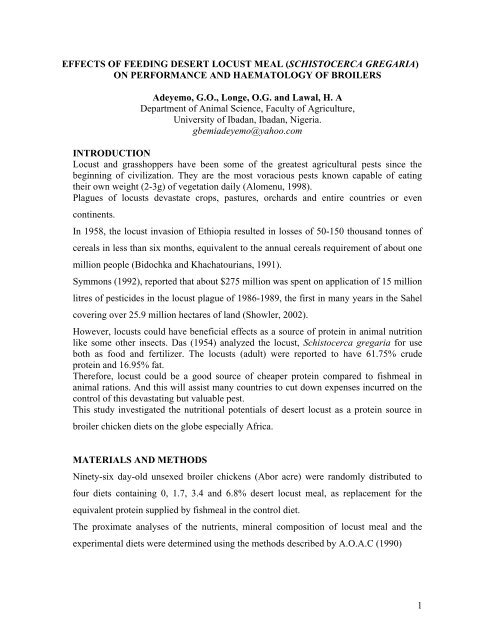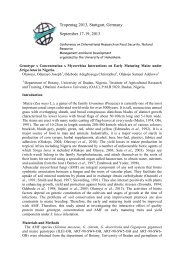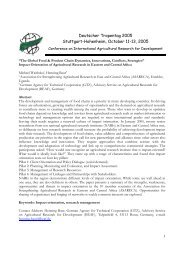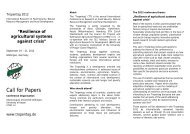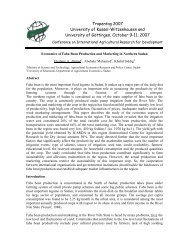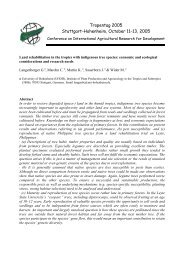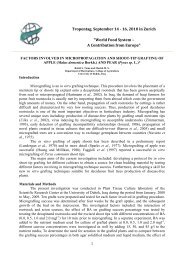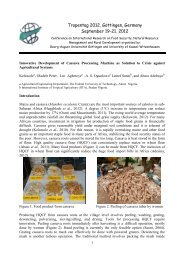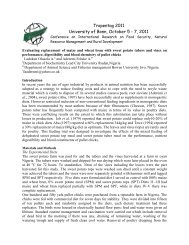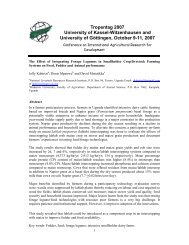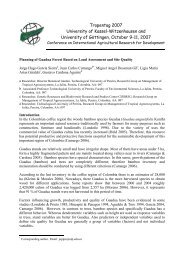Effects of Feeding Desert Locust Meal (Schistocerca gregaria) on ...
Effects of Feeding Desert Locust Meal (Schistocerca gregaria) on ...
Effects of Feeding Desert Locust Meal (Schistocerca gregaria) on ...
You also want an ePaper? Increase the reach of your titles
YUMPU automatically turns print PDFs into web optimized ePapers that Google loves.
EFFECTS OF FEEDING DESERT LOCUST MEAL (SCHISTOCERCA GREGARIA)<br />
ON PERFORMANCE AND HAEMATOLOGY OF BROILERS<br />
Adeyemo, G.O., L<strong>on</strong>ge, O.G. and Lawal, H. A<br />
Department <str<strong>on</strong>g>of</str<strong>on</strong>g> Animal Science, Faculty <str<strong>on</strong>g>of</str<strong>on</strong>g> Agriculture,<br />
University <str<strong>on</strong>g>of</str<strong>on</strong>g> Ibadan, Ibadan, Nigeria.<br />
gbemiadeyemo@yahoo.com<br />
INTRODUCTION<br />
<str<strong>on</strong>g>Locust</str<strong>on</strong>g> and grasshoppers have been some <str<strong>on</strong>g>of</str<strong>on</strong>g> the greatest agricultural pests since the<br />
beginning <str<strong>on</strong>g>of</str<strong>on</strong>g> civilizati<strong>on</strong>. They are the most voracious pests known capable <str<strong>on</strong>g>of</str<strong>on</strong>g> eating<br />
their own weight (2-3g) <str<strong>on</strong>g>of</str<strong>on</strong>g> vegetati<strong>on</strong> daily (Alomenu, 1998).<br />
Plagues <str<strong>on</strong>g>of</str<strong>on</strong>g> locusts devastate crops, pastures, orchards and entire countries or even<br />
c<strong>on</strong>tinents.<br />
In 1958, the locust invasi<strong>on</strong> <str<strong>on</strong>g>of</str<strong>on</strong>g> Ethiopia resulted in losses <str<strong>on</strong>g>of</str<strong>on</strong>g> 50-150 thousand t<strong>on</strong>nes <str<strong>on</strong>g>of</str<strong>on</strong>g><br />
cereals in less than six m<strong>on</strong>ths, equivalent to the annual cereals requirement <str<strong>on</strong>g>of</str<strong>on</strong>g> about <strong>on</strong>e<br />
milli<strong>on</strong> people (Bidochka and Khachatourians, 1991).<br />
Symm<strong>on</strong>s (1992), reported that about $275 milli<strong>on</strong> was spent <strong>on</strong> applicati<strong>on</strong> <str<strong>on</strong>g>of</str<strong>on</strong>g> 15 milli<strong>on</strong><br />
litres <str<strong>on</strong>g>of</str<strong>on</strong>g> pesticides in the locust plague <str<strong>on</strong>g>of</str<strong>on</strong>g> 1986-1989, the first in many years in the Sahel<br />
covering over 25.9 milli<strong>on</strong> hectares <str<strong>on</strong>g>of</str<strong>on</strong>g> land (Showler, 2002).<br />
However, locusts could have beneficial effects as a source <str<strong>on</strong>g>of</str<strong>on</strong>g> protein in animal nutriti<strong>on</strong><br />
like some other insects. Das (1954) analyzed the locust, <str<strong>on</strong>g>Schistocerca</str<strong>on</strong>g> <str<strong>on</strong>g>gregaria</str<strong>on</strong>g> for use<br />
both as food and fertilizer. The locusts (adult) were reported to have 61.75% crude<br />
protein and 16.95% fat.<br />
Therefore, locust could be a good source <str<strong>on</strong>g>of</str<strong>on</strong>g> cheaper protein compared to fishmeal in<br />
animal rati<strong>on</strong>s. And this will assist many countries to cut down expenses incurred <strong>on</strong> the<br />
c<strong>on</strong>trol <str<strong>on</strong>g>of</str<strong>on</strong>g> this devastating but valuable pest.<br />
This study investigated the nutriti<strong>on</strong>al potentials <str<strong>on</strong>g>of</str<strong>on</strong>g> desert locust as a protein source in<br />
broiler chicken diets <strong>on</strong> the globe especially Africa.<br />
MATERIALS AND METHODS<br />
Ninety-six day-old unsexed broiler chickens (Abor acre) were randomly distributed to<br />
four diets c<strong>on</strong>taining 0, 1.7, 3.4 and 6.8% desert locust meal, as replacement for the<br />
equivalent protein supplied by fishmeal in the c<strong>on</strong>trol diet.<br />
The proximate analyses <str<strong>on</strong>g>of</str<strong>on</strong>g> the nutrients, mineral compositi<strong>on</strong> <str<strong>on</strong>g>of</str<strong>on</strong>g> locust meal and the<br />
experimental diets were determined using the methods described by A.O.A.C (1990)<br />
1
At the end <str<strong>on</strong>g>of</str<strong>on</strong>g> the starter phase, (day 28), a bird per replicate was randomly selected<br />
making a total <str<strong>on</strong>g>of</str<strong>on</strong>g> 3-birds per treatment. The birds were bled from the neck via the jugular<br />
vein from which blood was collected for haematological and serum metabolite studies<br />
Analysis <str<strong>on</strong>g>of</str<strong>on</strong>g> variance <str<strong>on</strong>g>of</str<strong>on</strong>g> the data collected was carried out using SAS methods <str<strong>on</strong>g>of</str<strong>on</strong>g> 1999 at<br />
5% level <str<strong>on</strong>g>of</str<strong>on</strong>g> probability to assess significant differences.<br />
Treatment means were separated using Duncan’s multiple range test (Duncan, 1980).<br />
RESULTS<br />
Proximate compositi<strong>on</strong> <str<strong>on</strong>g>of</str<strong>on</strong>g> locust meal revealed that the sample used for this study has a<br />
crude protein <str<strong>on</strong>g>of</str<strong>on</strong>g> 52.3% <strong>on</strong> dry matter basis. The ether extract, crude fibre and Ash were<br />
12.00, 19.00 and 10.00 percent respectively.<br />
Results showed no significant differences (p>0.05) am<strong>on</strong>g the treatment means.<br />
The best FCR was obtained from treatment 2 (1.94) for the starter phase when the locust<br />
meal was used to replace 50% protein c<strong>on</strong>tributed by the fishmeal in the diet.<br />
No significant differences (p.>0.05) were observed am<strong>on</strong>g the means for the various<br />
haematological indices examined.<br />
Table 1: Proximate compositi<strong>on</strong> <str<strong>on</strong>g>of</str<strong>on</strong>g> locust meal (%)<br />
Dry matter 94.00<br />
Crude protein 52.30<br />
Ether extracts 12.00<br />
Ash 10.00<br />
2
Table 2: Performance Characteristics <str<strong>on</strong>g>of</str<strong>on</strong>g> Broilers Fed <str<strong>on</strong>g>Desert</str<strong>on</strong>g> <str<strong>on</strong>g>Locust</str<strong>on</strong>g> <str<strong>on</strong>g>Meal</str<strong>on</strong>g> Diets<br />
Parameters 1 2 3 4<br />
Ave. total feed<br />
intake(g/bird)<br />
4257.17 4658.28 3919.31 3918.39<br />
Ave. total feed weight<br />
gain(g/bird)<br />
1852.53 2097.43 1692.08 1722.95<br />
Feed C<strong>on</strong>versi<strong>on</strong><br />
Ratio(0-8 wks)<br />
2.30 2.22 2.32 2.27<br />
Feed C<strong>on</strong>versi<strong>on</strong><br />
Ratio(starter phase)<br />
2.09 1.94 2.29 2.03<br />
Feed C<strong>on</strong>versi<strong>on</strong> Ratio<br />
(Finisher phase)<br />
2.36 2.32 2.33 2.35<br />
Table 3: Haematological Indices <str<strong>on</strong>g>of</str<strong>on</strong>g> Broilers Fed <str<strong>on</strong>g>Desert</str<strong>on</strong>g> <str<strong>on</strong>g>Locust</str<strong>on</strong>g> <str<strong>on</strong>g>Meal</str<strong>on</strong>g> Diets<br />
Parameters 1 2 3 4<br />
PCV (%) 34.33 33.33 34.67 33.33<br />
Haemoglobin(g/dl) 11.23 10.87 7.83 10.83<br />
RBC x10 6 (µ/mm 3 ) 2.93 1.85 2.60 2.16<br />
WBC<br />
17.18 15.12 17.53 16.62<br />
x10 3 (µ/mm 3 )<br />
Platelets x10 3 /mm 3 110.67 106.33 120.67 121.00<br />
MCV (%) 119.67 191.67 147.67 184.33<br />
MCH (%) 32.33 32.33 31.67 32.33<br />
Lymph (%) 68.00 71.00 70.00 69.33<br />
Neutrophils (%) 1.33 1.00 1.67 1.67<br />
Eosinophils (%) 1.33 1.50 1.33 1.33<br />
CONCLUSION<br />
The result indicates that desert locust has great potential as a protein source in broiler<br />
diets without causing any physiological disorder as reflected in the haematological<br />
analysis.<br />
3
REFERENCES<br />
Alomenu, H.S. (1998). Current trend in African migratory locust plague preventi<strong>on</strong>.<br />
Outlook <strong>on</strong> Agriculture. 14, 165-173.<br />
A.O.A.C. (1990). Associati<strong>on</strong> <str<strong>on</strong>g>of</str<strong>on</strong>g> Official Analytical Chemists, Official methods <str<strong>on</strong>g>of</str<strong>on</strong>g><br />
anaysis 15 th ed Washingt<strong>on</strong> D.C.<br />
Bidochka, M.J. and Khachatourians, G.G. (1991). The implicati<strong>on</strong> <str<strong>on</strong>g>of</str<strong>on</strong>g> metabolic acids<br />
produced by Beauveria bassian in pathogenesis <str<strong>on</strong>g>of</str<strong>on</strong>g> the migatory grasshopper, Melanoplus<br />
sanguinipes. Journal <str<strong>on</strong>g>of</str<strong>on</strong>g> invertebrate pathology 58, 106-117.<br />
Das, S. (1954) <str<strong>on</strong>g>Locust</str<strong>on</strong>g> as food as manure. India Arming 6:412.<br />
Duncan, D.P. (1980). Multiple range and multiple F-test. Biometrics 11:1-42.<br />
SAS Institute, (1999).SAS® User Guide: Statistics. Versi<strong>on</strong> 9 Editi<strong>on</strong>. SAS Institute,<br />
Inc., Cary, NC. U.S.A.<br />
Showler A. T. (2002) A summary <str<strong>on</strong>g>of</str<strong>on</strong>g> c<strong>on</strong>trol strategies for the desert locust, <str<strong>on</strong>g>Schistocerca</str<strong>on</strong>g><br />
<str<strong>on</strong>g>gregaria</str<strong>on</strong>g> (Forskål) Agriculture, Ecosystems & Envir<strong>on</strong>ment Volume 90, Issue 1, June<br />
2002, Pages 97-103<br />
Symm<strong>on</strong>s P. (1992) Strategies to combat the desert locust Crop protecti<strong>on</strong> ISSN 0261-<br />
2194 volume. 11:3, pp. 206-212<br />
4


